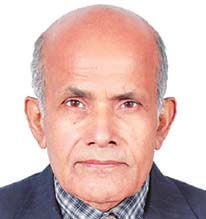Columns
Plight of Nepalis in Russian army
Poverty and desperation force young Nepalis to take risk their lives in foreign conflicts.
Hari Bansh Jha
The history of Nepalis serving in foreign armies dates back more than 200 years, primarily focused on recruitment into the British and Indian militaries. However, the participation of Nepalis in the Russian army is a recent phenomenon. It emerged in the wake of the Russia-Ukraine war that began in February 2022. By May 2023, reports surfaced that Nepalis were being recruited to fight for Russia despite the absence of any formal agreements between the two countries. This recruitment has exposed several Nepalis to grave risks and resulted in tragic loss of lives.
Unconfirmed reports suggest that 600 to 1,000 Nepalis have joined the Russian military. Many of these individuals arrived in Russia on student or tourist visas, facilitated by human traffickers who promised lucrative jobs in the Russian armed forces. These traffickers reportedly charge between $1,500 to $2,500 per person in the name of providing such opportunities.
Nepal’s law prohibits its citizens from joining foreign militaries, except in cases involving long-standing treaties with India and the United Kingdom. Nevertheless, the allure of a stable income in a foreign land has driven many in Nepal, often from economically disadvantaged backgrounds, to walk on this dangerous path. While the Government of Nepal has arrested some of those involved in trafficking, the efforts to control this illicit activity remain inadequate.
The plight of Nepali soldiers in the Russian army is a stark reminder of the dangers of being drawn into a foreign conflict. Media reports indicate that around 40 Nepalis have died in the conflict with Ukraine, with many others missing or captured as prisoners of war. A significant factor contributing to these casualties is the inadequate training these individuals received before being deployed to the front lines. Their lack of combat experience, coupled with minimal proficiency in the Russian language, put them at extreme risk. This loss has caused outrage in Nepal, with growing calls for the Russian government to halt its recruitment efforts and repatriate the bodies of those killed.
In response to the outcry from Nepal, diplomatic efforts were initiated to address the recruitment issue. The government of Nepal has been in regular communication with Russian authorities to facilitate the safe return of its citizens. Diplomatic channels have been used to negotiate compensation for the families of the deceased or those who were injured in the war. However, there remains limited information on the compensation these families might receive. They are anticipated to receive approximately $150,000, while those injured may receive about $33,000. Nonetheless, these compensations cannot truly alleviate the families’ pain and suffering if they materialise.
The underlying cause driving Nepalis to risk their lives in foreign armies is ingrained in Nepal's economic struggles. The country's persistent unemployment problem, exacerbated by ineffective government policies, has left its youth with few opportunities for gainful employment. Agriculture has become unattractive for many due to rising production costs and stagnant market prices. Consequently, a significant portion of Nepal's youth has turned away from farming and is opting for foreign employment.
In 2023, over 741,000 Nepalese citizens, including 661,000 men and 80,000 women, left the country searching for work. The Terai region, in particular, has seen a mass exodus, with the Dhanusha district sending the largest number of workers abroad, followed by Jhapa, Morang, Siraha and Mahottari. Traditionally reliant on agricultural employment, these districts have been unable to offer viable livelihoods to their residents, forcing many to seek jobs in countries like Malaysia, the Gulf States, and others.
A few decades ago, the primary destination for Nepali migrant workers was India, particularly the states of Haryana, Punjab and Delhi. However, labour migration has shifted towards other global markets in recent years as Nepalis seek better wages and working conditions in more distant lands.
Nepal is not alone paying the price in the Russian-Ukraine war. Reports indicate that Indian citizens have also been recruited into the Russian military, facing similar hardships and casualties. The Indian government, like Nepal, has been in talks with Russian officials to secure the release and safe return of its citizens. The plight of these soldiers has drawn attention to the broader issue of economic migration in South Asia, where large populations are forced to leave their home countries due to a lack of opportunities.
In Nepal, family members of those recruited into the Russian army have staged hunger strikes, frustrated by what they perceive as insufficient government action to stop the recruitment. They also submitted an 11-point memorandum to former Home Minister Rabi Lamichhane, demanding the safe rescue of their loved ones serving in the Russian army, as well as financial relief for the families of those killed in the war. These protests highlight the desperate situation faced by both the soldiers and their families, who feel abandoned by the state.
The case of Nepali citizens joining the Russian army is a tragic consequence of a much larger problem: The government's failure to provide adequate employment opportunities at home. Driven by poverty and desperation, young Nepali men and women are forced to take extreme measures, including risking their lives in foreign conflicts. The situation exposes the inadequacies of Nepal's planning and policies, which have been unable to address the root causes of migration or create sustainable livelihoods for its citizens.
The government's response, though belated, has included diplomatic engagement and promises of compensation. However, this is not enough to reverse the tide of migration or to prevent future tragedies. Nepal must urgently address its unemployment crisis, particularly in the agricultural sector, which has historically been a source of employment for the majority of its population. If the youth continue to abandon their homeland in search of work, the future of Nepal's economy, and its social fabric, appears bleak.




 15.76°C Kathmandu
15.76°C Kathmandu















